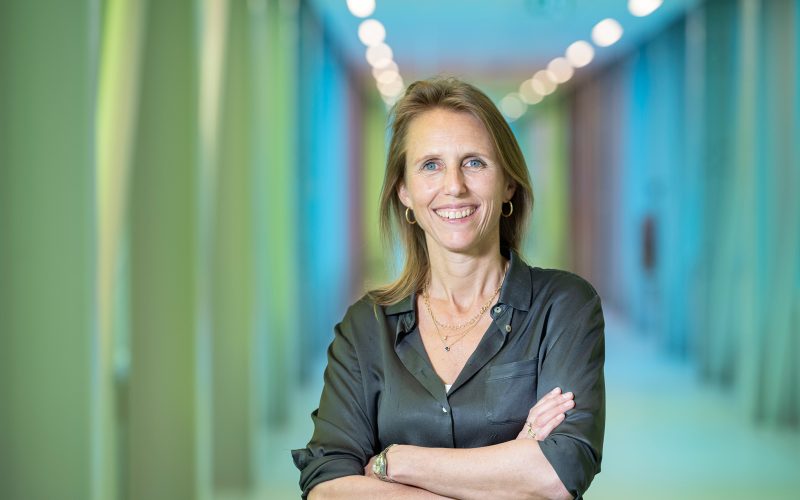Sabine Fuchs, who has been Professor of Metabolic Diseases and Innovative Therapies for a year, gave her inaugural lecture on 11 July. The lecture, entitled “To the core”, is a plea to invest now in innovation and research to cure serious metabolic diseases and to implement these treatments in a responsible manner so that they become accessible to as many patients as possible.
Sabine begins her argument by noting that, thanks to improved diagnostics, more and more metabolic diseases are being identified. But treatments are lagging behind. And that is serious, because metabolic diseases are the most deadly among children. New treatments must be developed quickly, because children can suffer damage every day. That damage is often preventable, but rarely reversible. Sabine: “That’s why we need to treat early, before irreparable damage occurs. It takes too long to develop a treatment for each of these rare diseases. That’s why I think we need to develop a more general strategy that we can then personalise for all those different metabolic patients who cannot yet be treated adequately.”
Her research initially focused on the liver, the most important metabolic organ where processes such as the conversion and storage of fats, proteins and carbohydrates take place. Thanks to close collaboration with Prof. Clevers’ group, she was able to create liver organoids (‘mini-livers’) from liver tissue from patients with metabolic diseases in order to study diseases and test treatments. She also wanted to transplant the liver organoids to restore metabolic function, but this was not successful: they turned out to be insufficiently liver-like. “Only recently have we succeeded in creating ‘real liver organoids’ (HeLLOs). These are so similar to liver tissue that we have started a start-up (HELLO R&D) to test drug toxicity.”
For patients with metabolic diseases, progress was not fast enough. That is why she sought a more general strategy. Although metabolic diseases are very different, the basic disease mechanism is always the same: they are hereditary diseases caused by a DNA change in the cell nucleus. This also changes the mRNA, the instruction for the cell, causing the cell to produce a different protein or enzyme that is then unable to perform its function properly or at all.
Sabine wants to tackle these diseases at their genetic root cause. She arranged for a young patient, Bjorn, to receive a new mRNA therapy that encodes the enzyme that is not working in his body. “Since Bjorn has been receiving the treatment every two weeks, he has become a happier, more open boy with more energy. This international ‘first-in-human’ study shows that you can temporarily instruct cells to produce an enzyme. It’s a fantastic development, but the problem is that mRNA only works temporarily; we’re not repairing the error in the DNA. So Bjorn has to go to the hospital every two weeks for an infusion. We’re not there yet,” says Sabine.
This dilemma – that DNA is not repaired and there is still no cure – is the reason for the title of Sabine’s inaugural lecture: To the core. Her mission focuses on repairing the cause of metabolic diseases – literally at the core, where the DNA is located – through personalised gene correction. This sounds like science fiction, but thanks to rapid technological developments such as CRISPR/Cas – molecular scissors that can cut and paste DNA with great precision – and the techniques derived from it (base and prime editing), this is now becoming a reality.
Last month, exactly what Sabine Fuchs and her team had in mind happened in the US. A personalised gene correction treatment was developed within six months for a baby with a rare metabolic disease. Thanks to a unique collaboration between academia, industry and regulatory authorities, the therapy could be developed and applied quickly, before irreparable damage occurred to the patient. Sabine: “So it is possible! ”
“This was an ideal patient, with all circumstances favourable. I want to make this possible for as many patients with metabolic diseases as possible. The technique used here, base editing, only works for specific mutations. Prime editing is more widely applicable, so that’s what we’re focusing on. In this patient, the liver was treated, which is the easiest organ. We are also focusing on other organs.”
Sabine believes that we must now take decisive action. Together with researchers, doctors, patients, policymakers, ethicists, regulatory authorities and the pharmaceutical industry, she wants to market gene correction therapies in a responsible and smart way as platform technology: only a small element needs to be adapted for each patient. Only in this way will these treatments be accessible to as many patients as possible, without creating further inequality.
She believes that we must continue to innovate and invest in fundamental research. These treatments are based on fundamental techniques such as organoids and CRISPR/Cas. Now that scientific research is facing significant cutbacks in the US, we must continue to invest in Europe, the Netherlands and specifically here in Utrecht, at the largest science park in the Netherlands. “Let’s value innovation and develop these treatments academically here. For Bjorn and all other children with metabolic diseases!”
